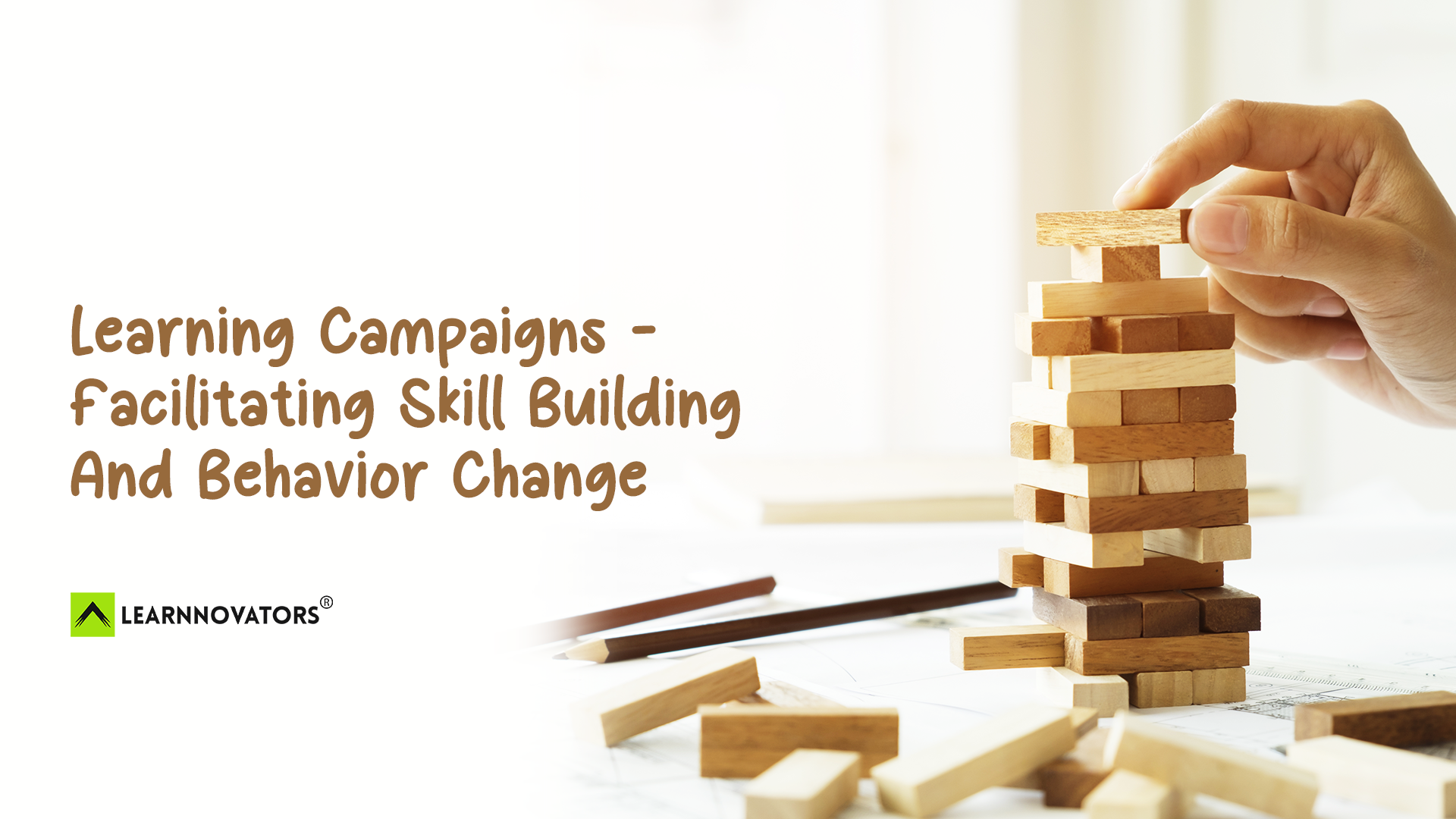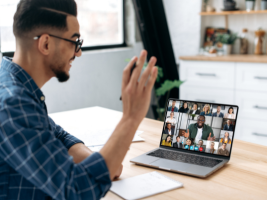Many of us have grown up hearing about marketing campaigns, advertising campaigns and political campaigns, but learning campaigns are a relatively new kid on the block. The idea has picked up pace recently, so much so that almost everyone talks about it. Specifically, there’s a lot of talk about L&D having to ‘think like a marketer’ and using ‘marketing campaigns for learning’. But not many know the differences, why learning campaigns work, or how to do them well.
So that’s my goal in this article. I will first address the difference between a learning campaign and a marketing-for-learning one. And then I’ll break down what makes learning campaigns work, and then finally, I’ll talk about how to create an effective learning campaign.
A marketing-for-learning campaign is simply a marketing campaign. These campaigns are typically focused on promoting your learning product, such as an online course or a training program. Similar to marketing any other product or service, the objective of these campaigns is to attract potential learners and convince them to check out the learning course, or to create awareness about your L&D initiatives. They have nothing to do with how your learning programs are designed.
In contrast, learning campaigns are designed to facilitate actual learning, skill-building and long-term behavior change. Why are they such a big deal, and why do they work better than single-use courses?
For one, learning is not a single event. Of course, I’m not talking about learning that Vanuatu is a country in the Pacific Ocean, and that Port Vila is its capital. I’m referring to learning that involves building complex skills, or changing deeply ingrained behaviors.
Think back to the last time you learned something new. Can you say with confidence that you gained the necessary skills after going through one course, however well-designed it might have been? I’m pretty sure you can’t. This is because skill building is a complex activity that involves multiple learning, practice, reflection and reinforcement touchpoints, spaced out over a period of time.
Similarly, think about a time when you were trying to kick an unwanted habit, or start a new one. For instance, like exercising three times a week. By any chance, did you watch a fantastic video on the benefits of exercise for the body and mind, and then excitedly head out the door to meet your fitness instructor?
No, right? That’s because behavior change takes several touchpoints to reinforce the message over and over again, nudging you repeatedly to take action. The mere ‘knowledge’ that exercise is good for you isn’t enough to move you into acting.
With a learning campaign, it is possible to bring these touchpoints together in a cohesive manner, so as to build skills and change behavior. In a nutshell, here are a few reasons why learning campaigns work:
- Repetition: When you hear something once, it’s forgotten easily. But when you hear it repeatedly, the neural connections in your brain get stronger, making it more and more likely for you to remember. This is referred to as retrieval, specifically as retrieval practice. The more you rehearse or retrieve something from your memory, the more likely it is to stick with you. With a learning campaign, you can set up as many repetitions as necessary for the learning to stick.
- Spacing: For retrieval to be effective, it needs to be spaced out over certain intervals. Retrieving a concept immediately after learning it will not work as well as retrieving it after, say, a week, and then retrieving it again after another week, and so on. This is referred to as spaced retrieval or spaced repetition. Here again, learning campaigns come in handy, by making it possible to space these repetitions as required.
- Multimodal Delivery: By not restricting your content to a single format or mode, you appeal to the different senses of learners. That is, the same messages can be repurposed and delivered through multiple mediums, thus ensuring more / better repetition without causing content fatigue.
- Right-sized Content: Note that I said “right-sized” and not “byte-sized”. Microlearning has been a buzzword for a few years now, and I don’t want the term to derail what we’re trying to do. Basically, what I’m saying is that you can create learning nuggets that are as small or big as they have to be, without compromising on your learning goals. If an objective needs 25 minutes to be covered comprehensively, then so be it. If another can be covered in 3 minutes, then by all means, go for it.
- Adaptive Learning: With campaigns, it is possible to create a learner-centered experience that is responsive to individual learner needs and abilities. A simple way to introduce adaptiveness is by including a pre-test at the beginning of the campaign, and then serving up appropriate learning assets based on the learner’s answers. Other, more complex, ways could include adjusting the level of difficulty of each quiz or activity based on the learner’s performance in previous ones.
- Engagement: If you do all the above right, then engagement is largely guaranteed. The deep kind of engagement where the learner is excited about the content, and wants to try to incorporate what they’ve learned in real life.
So, how do you design a successful learning campaign?
Before we get into the how, I’d like to give you a small reminder that designing a campaign is not different from designing any other learning solution. All the principles of good design should apply here as well. This means setting clear goals and objectives, understanding your audience, identifying the WIIFM, and so on.
Below, I’ll touch upon the things you’ll do specifically for learning campaigns but may not apply for a typical e-learning course project.
- Identify how you will deliver the campaign and the platforms you will use: Your LMS (or wherever the courses live) will likely be the primary platform through which you’ll deliver your campaign. Other channels could include e-mail, intranet and other communication platforms that are in use in your organization (Slack, MS Teams, or the like). And if your organization allows it, do consider external channels as well (LinkedIn, Facebook, etc.). Hopefully, you will have obtained the information in your learner analysis, where you identify the channels in which your learners hang out. Don’t be afraid to look for the non-obvious and offline channels as well. These could include the cafeteria where teams congregate, flyers or posters placed in strategic locations, the office reception area, or even employee desktops or the landing page of your LMS or intranet.
- Establish how you’ll measure your results: This is applicable to all types of learning and not just to campaigns, but I wanted to include it here because it’s the last thing that designers tend to think about. Learning impact measurement often happens as an afterthought, if it’s even considered. Don’t be like that. Once your goals are defined, decide on how you want to measure the outcome. This could include measuring behavior change over time, or something as basic as the number of people who’ve gone through the campaign. While the latter is less than ideal, it is okay as long as you’ve agreed on the measure upfront with your stakeholders.
- Employ a variety of media and modes: We have already covered the benefits of multimodal learning. So leverage that in your campaign. It could include videos, podcasts, interactive quizzes, and more. It could even include e-learning courses broken down into individual easy-to-learn pieces. In a discussion about a learning campaign, someone argued that this is just like a series of microlearning courses. That’s a possibility, but a learning campaign is actually much more than that. In marketing terminology, each individual piece is called an ‘asset’. So, decide on what kind of assets you want to create. Examples include microlearning modules, videos, posters, flyers, desktop banners, and more.
- Set a timeframe: How long will the campaign run? How often do learners see the communication from you? Consider the learners’ context and the platforms you’ve planned to use, and create your assets accordingly.
- Leverage the power of repetition and spacing: Spaced repetition, as we’ve talked about earlier, is key to building skills as well as changing behavior. Make sure that these repetitions involve active participation from the learner, and not just passive recall. A great way to do that would be to use scenario-based quizzes that place learners in a situation, and require them to make decisions. Each of these quizzes comprising a number of questions could form an asset in your campaign.
- Ensure that your campaign is nudging learners toward the desired action: By ‘desired action’, I’m referring to the goal that you initially defined for your campaign. Nudges could include reflection questions that get learners to think about how they will act in a particular situation, or could be about reminding learners to perform certain behaviors. To give you an example, for a campaign on building leadership skills, a nudge could be a simple question such as “Did you recognize someone on your team today?”.
Learning campaigns are an effective way to build skills and drive long-term behavior change. So go ahead and ace them like a pro!
Written by Srividya Kumar, Co-Founder @ Learnnovators






